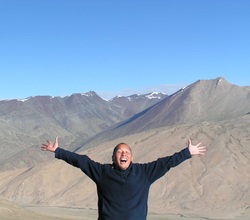
TAI CHI, RELAXATION & MINDFULNESS
INTRODUCTION
My name is John Linney, I practice and teach tai chi in and around Cambridge. Recently I had the pleasure of meeting some of you at the last Cambridgeshire Lupus Group's AGM. There is currently interest in how tai chi practice may benefit some of those working with some of the symptoms of Lupus. For this reason I have been asked to write a short introduction to tai chi.
For centuries the Chinese have been using tai chi to help them to live longer, happier, and healthier lives. Western medical scientists are finding empirical evidence indicating that tai chi can benefit individuals in alleviating symptoms of rheumatic disorders, osteoarthritis and other musculoskeletal disorders often bringing positive developments in well-being (some references below).
Tai chi (or tai chi chuan or taiji or taijiquan) is a mindful martial art with many aspects. Its training methods mean that it can be introduced as a low-impact set of mindful exercises that can be adapted to cater for ranges of needs. In this way tai chi has the potential to bring many physical benefits to those who may not otherwise be able to benefit from other exercise programmes.
Tai chi goes beyond being just a set of movements: it can sustain a lifetime of study opening up greater health, well-being, social benefits and becomes a way of being in the world. For most of us it will be important to find a teacher with sufficient experience of the whole picture to make sense of the tai chi jigsaw and has the skills and inclination to help establish us on our journey; like many things much of the learning in tai chi is through 'osmosis', it is important therefore that the instructor has enough experience to sufficiently embody the principles of tai chi.
Two central pillars in tai chi practice are relaxation and mindfulness.
TAI CHI, MINDFULNESS & RELAXATION
Mindfulness has two aspects – awareness and continuity of intention. We practice tai chi consciously cultivating awareness, especially bodily awareness; however as we literally slow the movements down we also catch up with ourselves, becoming more aware of our thoughts and emotions.
Our awareness forms a container in which to hold our experience, as our awareness grows the container gets bigger. When we hold our experience in this way we are able to more fully experience ourselves without getting overwhelmed or being driven by habitual reactions. This help us to relax into ourselves without pushing experience away or grasping habitually after comforting experiences. We have the potential to become more spacious and 'comfortable in our skins'. As we find more spaciousness we also relax emotionally and physically (ever noticed there's a connection between your state of mind and how you hold your shoulders, or the quality of your breath?).
In tai chi we consciously maintain the intention to be aware and actively encourage the letting go of unnecessary physical tensions, cultivating the quality of 'song' (Chinese word pronounced 'sung') that blends physical relaxation with more optimal physical alignments. In turn this physical relaxation supports mental and emotional relaxation. The characteristically slow movements of tai chi are a training method helping us to work with our ingrained habits through awareness. In traditional Chinese philosophical terms tai chi cultivates the 'yin' (relaxation, receptivity, 'parasympathetic nervous system') and subdues excess 'yang' (the fight / flight or stress response).
TAI CHI TRAINING METHODS
Tai chi uses a variety of training methods including:
BENEFITS OF PRACTICE
Nothing arises without the right conditions and some regular practice is important to realise potential benefits of tai chi. There can be a learning curve when starting tai chi but it is important to remember that we all start somewhere: initially learning with broad brush strokes, we gradually refine these and use our practice to cultivate poise, alignment, relaxation and spaciousness.
My own path of learning tai chi has not been without its challenges but has also been one of unfolding satisfaction and helps me to enjoy life more to the full – I was resistant to starting tai chi as I thought it was 'namby-pamby': after over 13 years or practice and 7 years of teaching I am so glad I didn't let that wrong view stop me!
(Written for publication in Cambridgeshire Lupus Group newsletter, June 2013)
REFERENCES
Tai Chi & Rheumatic Diseases C. Wang, Rheum Dis Clin North Am. 2011 February, 37(1): pp19-32
Tai Chi Is Effective in Treating Knee Osteoarthritis: A Randomised Controlled Trial C. Wang, C.H. Schmid, P.L. Hibberd, R. Kalish, R. Roubenoff, R. Rones & T. McAlindon, Arthritis & Rheumatism, Vol 61, No 11, Nov 15 2009, pp 1545-1553
The Effectiveness of Tai Chi for Chronic Musculoskeletal Pain Conditions: A Systematic Review and Meta-Analysis A. Hall, C. Maher, J. Latimer & M. Ferreira, Arthritis & Rheumatism, Vol 61, No 6, Jun 15 2009, pp 717-724
Tai Chi Exercise for Treatment of Pain and Disability in People with Persistent Low Back Pain: A Randomised Controlled Trial A.M. Hall, C.G. Maher, P. Lam, M. Ferreira & J. Latimer, Arthritis Care & Research, Vol 63, No 11, Nov 2011, pp 1576-1583
INTRODUCTION
My name is John Linney, I practice and teach tai chi in and around Cambridge. Recently I had the pleasure of meeting some of you at the last Cambridgeshire Lupus Group's AGM. There is currently interest in how tai chi practice may benefit some of those working with some of the symptoms of Lupus. For this reason I have been asked to write a short introduction to tai chi.
For centuries the Chinese have been using tai chi to help them to live longer, happier, and healthier lives. Western medical scientists are finding empirical evidence indicating that tai chi can benefit individuals in alleviating symptoms of rheumatic disorders, osteoarthritis and other musculoskeletal disorders often bringing positive developments in well-being (some references below).
Tai chi (or tai chi chuan or taiji or taijiquan) is a mindful martial art with many aspects. Its training methods mean that it can be introduced as a low-impact set of mindful exercises that can be adapted to cater for ranges of needs. In this way tai chi has the potential to bring many physical benefits to those who may not otherwise be able to benefit from other exercise programmes.
Tai chi goes beyond being just a set of movements: it can sustain a lifetime of study opening up greater health, well-being, social benefits and becomes a way of being in the world. For most of us it will be important to find a teacher with sufficient experience of the whole picture to make sense of the tai chi jigsaw and has the skills and inclination to help establish us on our journey; like many things much of the learning in tai chi is through 'osmosis', it is important therefore that the instructor has enough experience to sufficiently embody the principles of tai chi.
Two central pillars in tai chi practice are relaxation and mindfulness.
TAI CHI, MINDFULNESS & RELAXATION
Mindfulness has two aspects – awareness and continuity of intention. We practice tai chi consciously cultivating awareness, especially bodily awareness; however as we literally slow the movements down we also catch up with ourselves, becoming more aware of our thoughts and emotions.
Our awareness forms a container in which to hold our experience, as our awareness grows the container gets bigger. When we hold our experience in this way we are able to more fully experience ourselves without getting overwhelmed or being driven by habitual reactions. This help us to relax into ourselves without pushing experience away or grasping habitually after comforting experiences. We have the potential to become more spacious and 'comfortable in our skins'. As we find more spaciousness we also relax emotionally and physically (ever noticed there's a connection between your state of mind and how you hold your shoulders, or the quality of your breath?).
In tai chi we consciously maintain the intention to be aware and actively encourage the letting go of unnecessary physical tensions, cultivating the quality of 'song' (Chinese word pronounced 'sung') that blends physical relaxation with more optimal physical alignments. In turn this physical relaxation supports mental and emotional relaxation. The characteristically slow movements of tai chi are a training method helping us to work with our ingrained habits through awareness. In traditional Chinese philosophical terms tai chi cultivates the 'yin' (relaxation, receptivity, 'parasympathetic nervous system') and subdues excess 'yang' (the fight / flight or stress response).
TAI CHI TRAINING METHODS
Tai chi uses a variety of training methods including:
- 'Loosening exercises' (sometimes exercises from chi kung are used) helping the student understand some of the basic principles of tai chi in a relatively simple context as well as cultivating the quality of 'song';
- Tai chi 'form', a choreographed sequence of movements, provides a slightly more complex context for understanding and cultivation. Different styles of tai chi offer different forms. Simplified, sitting and other forms adapted for particular contexts can also be practised. The forms introduce movements from the martial tradition;
- Partner work provides a dynamic context to, again, understand and cultivate tai chi principles. Partner work should be approached as awareness and sensitivity exercises rather than martial competitions – not only can this be a more nourishing way to work but, in time, paradoxically real martial skill that overcomes strength and speed can be cultivated;
- In time the whole of life provides a context for us to understand and cultivate tai chi principles helping us to be more mindful and relaxed in all our affairs.
BENEFITS OF PRACTICE
Nothing arises without the right conditions and some regular practice is important to realise potential benefits of tai chi. There can be a learning curve when starting tai chi but it is important to remember that we all start somewhere: initially learning with broad brush strokes, we gradually refine these and use our practice to cultivate poise, alignment, relaxation and spaciousness.
My own path of learning tai chi has not been without its challenges but has also been one of unfolding satisfaction and helps me to enjoy life more to the full – I was resistant to starting tai chi as I thought it was 'namby-pamby': after over 13 years or practice and 7 years of teaching I am so glad I didn't let that wrong view stop me!
(Written for publication in Cambridgeshire Lupus Group newsletter, June 2013)
REFERENCES
Tai Chi & Rheumatic Diseases C. Wang, Rheum Dis Clin North Am. 2011 February, 37(1): pp19-32
Tai Chi Is Effective in Treating Knee Osteoarthritis: A Randomised Controlled Trial C. Wang, C.H. Schmid, P.L. Hibberd, R. Kalish, R. Roubenoff, R. Rones & T. McAlindon, Arthritis & Rheumatism, Vol 61, No 11, Nov 15 2009, pp 1545-1553
The Effectiveness of Tai Chi for Chronic Musculoskeletal Pain Conditions: A Systematic Review and Meta-Analysis A. Hall, C. Maher, J. Latimer & M. Ferreira, Arthritis & Rheumatism, Vol 61, No 6, Jun 15 2009, pp 717-724
Tai Chi Exercise for Treatment of Pain and Disability in People with Persistent Low Back Pain: A Randomised Controlled Trial A.M. Hall, C.G. Maher, P. Lam, M. Ferreira & J. Latimer, Arthritis Care & Research, Vol 63, No 11, Nov 2011, pp 1576-1583




 RSS Feed
RSS Feed
